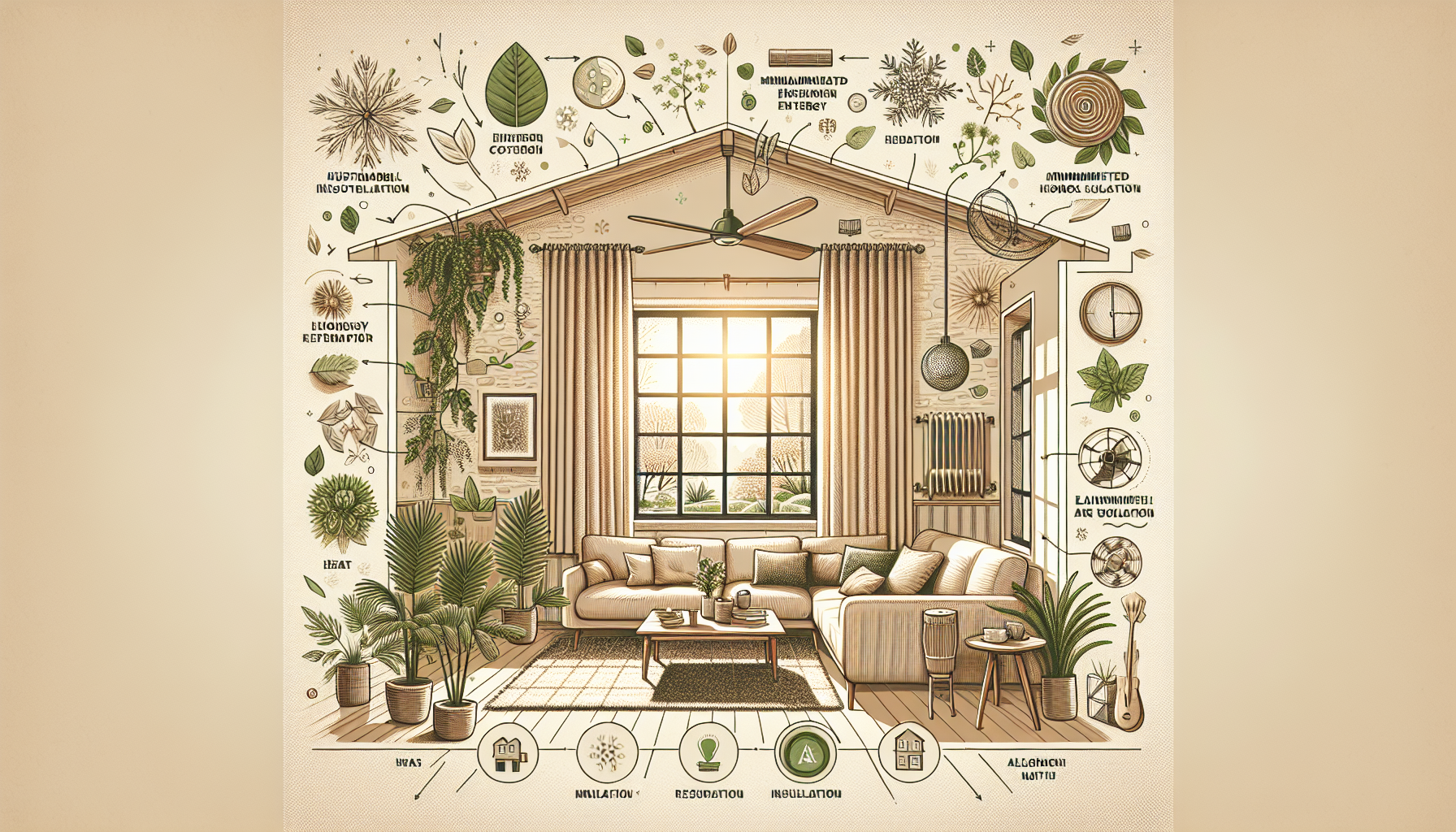Unlocking a Greener Summer: 18 Eco-Friendly Habits for a Sustainable Tomorrow

Summer is the perfect time to embrace eco-friendly habits and contribute to a greener tomorrow. With the right practices, you can not only reduce your environmental impact but also save money and improve your health. Join us as we explore 18 sustainable habits that will empower you to make a positive difference this summer and beyond.From reducing your energy consumption to conserving water, adopting the principles of waste reduction, and choosing eco-friendly modes of transportation, this article provides a comprehensive guide to help you live more sustainably. Additionally, we will also guide you on how to support eco-friendly businesses and contribute to environmental causes, making every aspect of your life a testament to your commitment to a greener future. As we navigate the challenges of climate change and environmental degradation, collective action is crucial. By embracing these sustainable habits, you join a growing movement of individuals who are actively working towards a healthier and more sustainable planet for generations to come.
Embrace Energy-Efficient Practices
Embrace Energy-Efficient Practices: Discover ways to reduce your energy footprint and save money on utility bills.
Thank you for reading this post, don't forget to subscribe!
Reducing your energy consumption is not only good for the environment, but it can also save you money on your utility bills. Here are a few simple ways to make your home more energy-efficient:
- Unplug electronics when not in use. Even when turned off, many electronics still draw power. Unplugging them when not in use can save you a significant amount of energy over time.
- Invest in Energy-Star appliances. Energy-Star appliances are designed to be more energy-efficient than standard appliances. When purchasing new appliances, look for the Energy-Star label to ensure you’re getting the most energy-efficient model.
- Utilize natural lighting. Open curtains and blinds during the day to let in natural light. This can help reduce your reliance on artificial lighting, which can save you energy and money.
By following these simple tips, you can reduce your energy consumption and save money on your utility bills. Making small changes in our daily habits can have a big impact on the environment and our wallets.
Unplug Electronics When Not in Use
Unplug Electronics When Not in Use: Eliminate standby power consumption by unplugging devices like chargers and appliances.
Standby power, also known as vampire power, is the electricity that electronic devices consume even when they are turned off. This can add up to a significant amount of energy waste over time. One of the simplest ways to reduce your standby power consumption is to unplug electronics when not in use.
Many electronics continue to draw power even when they are turned off. This is because they have features like clocks, remote controls, and other functions that require a constant power supply. Even small devices like phone chargers can draw power when they are plugged in but not charging a device.
Unplugging electronics when not in use is a simple way to reduce your energy consumption and save money on your utility bills. It also helps to extend the life of your electronics. When devices are constantly plugged in, they are exposed to voltage fluctuations and other power surges that can damage them over time.
By unplugging electronics when not in use, you can help to reduce your energy consumption, save money on your utility bills, and extend the life of your electronics. It’s a simple change that can make a big difference.
Invest in Energy-Star Appliances
Invest in Energy-Star Appliances: Choose appliances that meet energy efficiency standards, reducing your electricity usage.
Energy-Star is a government-backed program that helps consumers identify energy-efficient appliances. Appliances that meet Energy-Star standards are typically more expensive than standard appliances, but they can save you money on your energy bills over time.
Energy-Star appliances are designed to use less energy than standard appliances. This is achieved through a variety of measures, such as using more efficient motors, insulation, and components. As a result, Energy-Star appliances can help you reduce your electricity usage and save money on your utility bills.
When shopping for new appliances, look for the Energy-Star label. This label indicates that the appliance meets the government’s energy efficiency standards. You can also use the Energy-Star website to compare the energy efficiency of different appliances.
Investing in Energy-Star appliances is a smart way to reduce your energy consumption and save money on your utility bills. By choosing Energy-Star appliances, you can help to protect the environment and your wallet.
Utilize Natural Lighting
Utilize Natural Lighting: Open curtains and blinds during the day to maximize natural light, reducing the need for artificial illumination.
Natural light is a great way to brighten up your home and reduce your reliance on artificial lighting. By opening curtains and blinds during the day, you can let in natural light and reduce the need for electric lights.
Natural light has many benefits. It can help to improve your mood, boost your energy levels, and reduce eyestrain. Natural light can also help to improve your sleep quality and reduce your risk of developing certain health conditions, such as seasonal affective disorder (SAD).
In addition to the health benefits, using natural light can also save you money on your energy bills. Artificial lighting can account for a significant portion of your energy consumption. By reducing your reliance on artificial lighting, you can save money on your utility bills.
To maximize the amount of natural light in your home, open curtains and blinds during the day. You can also use sheer curtains or blinds to filter the light and reduce glare. If you have a room that doesn’t get much natural light, you can use skylights or solar tubes to bring in natural light.
Utilizing natural light is a simple and effective way to improve your health, save money on your energy bills, and reduce your environmental impact.
Conserve Water Wisely

Conserve Water Wisely: Implement strategies to minimize water usage and protect this precious resource.
Water is a precious resource that is essential for life. However, many of us take water for granted and waste it without realizing it. Conserving water is important for both environmental and financial reasons.
There are many simple ways to conserve water in your daily life. Here are a few tips:
- Fix leaky faucets and toilets. A leaky faucet can waste gallons of water per day. Check your faucets and toilets regularly for leaks and fix them as soon as possible.
- Install low-flow appliances. Low-flow appliances, such as showerheads and toilets, use less water than standard appliances. Replacing your old appliances with low-flow models can help you save water and money.
- Water plants strategically. Water plants deeply but less frequently to encourage healthy root growth and reduce evaporation.
By following these simple tips, you can conserve water and help to protect this precious resource.
Install Low-Flow Fixtures
Install Low-Flow Fixtures: Replace old faucets and showerheads with water-efficient models.
Low-flow fixtures are designed to use less water than standard fixtures. This can help you to reduce your water consumption and save money on your water bills.
Low-flow faucets and showerheads are available in a variety of styles and finishes, so you can find models that will match your bathroom or kitchen décor. When choosing low-flow fixtures, look for the WaterSense label. This label indicates that the fixture meets the Environmental Protection Agency’s (EPA) water efficiency standards.
Installing low-flow fixtures is a simple and effective way to reduce your water consumption. Here are a few tips for installing low-flow fixtures:
- Turn off the water supply. Before you begin, turn off the water supply to the fixture you are replacing.
- Remove the old fixture. Use a wrench to remove the old faucet or showerhead.
- Install the new fixture. Follow the manufacturer’s instructions to install the new low-flow fixture.
- Turn on the water supply. Once the new fixture is installed, turn on the water supply and check for leaks.
By installing low-flow fixtures, you can reduce your water consumption and save money on your water bills. You can also help to protect the environment by conserving water.
Water Plants Strategically
Water Plants Strategically: Water plants deeply but less frequently to promote healthy root growth and reduce evaporation.
Watering plants strategically is important for their health and growth. Watering too frequently can lead to root rot and other problems, while underwatering can cause plants to wilt and die.
The best way to water plants is to water them deeply but less frequently. This allows the water to penetrate deeply into the soil and reach the roots. Deep watering also encourages roots to grow deeper, which makes plants more drought-tolerant.
To water plants deeply, use a watering can or hose to soak the soil around the base of the plant. Water until the water begins to drain out of the bottom of the pot or container. Allow the soil to dry out completely before watering again.
The frequency with which you need to water your plants will vary depending on the type of plant, the size of the pot or container, and the weather conditions. As a general rule, plants need to be watered more frequently in hot, dry weather than in cool, humid weather.
By watering plants strategically, you can help them to grow healthy and strong. You can also reduce the amount of water you use and save money on your water bills.
Collect Rainwater for Watering
Collect Rainwater for Watering: Capture rainwater in barrels or tanks for use in irrigation.
Collecting rainwater for watering is a great way to conserve water and reduce your reliance on municipal water supplies. Rainwater is also free and it is naturally soft, which is good for plants.
To collect rainwater, you will need a rain barrel or tank. Rain barrels are typically made of plastic or metal and they can be purchased at most hardware stores. Rain tanks are larger than rain barrels and they are usually made of concrete or plastic. Rain tanks can be installed above or below ground.
To install a rain barrel, simply place it under a downspout. You may need to purchase a diverter to connect the downspout to the rain barrel. To install a rain tank, you will need to dig a hole in the ground and bury the tank. You will also need to connect the downspout to the rain tank.
Once you have installed your rain barrel or tank, you can start collecting rainwater. When it rains, the water will flow from the downspout into the rain barrel or tank. You can then use the collected rainwater to water your plants.
Collecting rainwater for watering is a simple and effective way to conserve water and reduce your environmental impact. It is also a great way to save money on your water bills.
3. Reduce, Reuse, and Recycle
Reduce, Reuse, and Recycle: Adopt the principles of waste reduction to minimize your environmental impact.
The principles of reduce, reuse, and recycle are a great way to minimize your environmental impact. Reducing the amount of waste you produce, reusing items instead of throwing them away, and recycling materials all help to conserve resources and protect the environment.
Reduce
Reducing the amount of waste you produce is the most effective way to minimize your environmental impact. Here are a few tips for reducing waste:
- Buy less stuff. Only buy things that you need and that you will use for a long time.
- Choose reusable products over disposable products. For example, use reusable shopping bags, water bottles, and coffee cups.
- Repair items instead of throwing them away. Many items can be repaired, so don’t be too quick to throw them away.
Reuse
Reusing items instead of throwing them away is a great way to reduce waste. Here are a few tips for reusing items:
- Donate old clothes and other items to charity.
- Use old clothes as rags or dust cloths.
- Use old containers to store food or other items.
- Repurpose old items into new ones. For example, you can turn an old t-shirt into a tote bag.
Recycle
Recycling materials helps to conserve resources and protect the environment. Here are a few tips for recycling:
- Recycle paper, plastic, metal, and glass.
- Check with your local recycling program to see what materials they accept.
- Rinse out food and beverage containers before recycling them.
- Flatten cardboard boxes before recycling them.
By adopting the principles of reduce, reuse, and recycle, you can minimize your environmental impact and help to protect the planet.
Reduce Plastic Consumption
Reduce Plastic Consumption: Carry reusable bags, water bottles, and utensils to avoid single-use plastics.
Single-use plastics are a major source of pollution. They can take hundreds of years to decompose and they often end up in our oceans, where they can harm marine life. Reducing your consumption of single-use plastics is a great way to help protect the environment.
One of the easiest ways to reduce your plastic consumption is to carry reusable bags, water bottles, and utensils. Reusable bags can be used for grocery shopping, errands, and other activities. Reusable water bottles can be used to stay hydrated throughout the day. And reusable utensils can be used for eating on the go.
Carrying reusable items is a simple way to make a big difference. By avoiding single-use plastics, you can help to reduce pollution and protect the environment.
Here are a few tips for reducing your plastic consumption:
- Bring your own reusable bags when you go shopping.
- Bring your own reusable water bottle when you go out.
- Bring your own reusable utensils when you eat on the go.
- Avoid using plastic straws and utensils.
- Choose products that are packaged in recyclable materials.
- Recycle plastic items whenever possible.
By following these tips, you can reduce your plastic consumption and help to protect the environment.
Reuse Items Creatively
Reuse Items Creatively: Find new purposes for old items instead of discarding them.
Reusing items creatively is a great way to reduce waste and save money. It can also be a fun and rewarding way to express your creativity.
There are endless possibilities for reusing old items. Here are a few ideas to get you started:
- Use old clothes as rags or dust cloths.
- Use old containers to store food or other items.
- Repurpose old furniture into new pieces.
- Turn old jewelry into new pieces.
- Use old toys as planters or decorations.
With a little creativity, you can find new purposes for almost any old item. So next time you’re about to throw something away, take a moment to think about whether there’s a way to reuse it instead.
Reusing items creatively has many benefits. It can help you to:
- Reduce waste
- Save money
- Be more creative
- Live a more sustainable lifestyle
So next time you’re about to throw something away, take a moment to think about whether there’s a way to reuse it instead. You might be surprised at what you can come up with!
Recycle Responsibly
Recycle Responsibly: Familiarize yourself with local recycling guidelines and dispose of recyclables accordingly.
Recycling is a great way to reduce waste and conserve resources. However, it’s important to recycle responsibly in order to ensure that your recyclables are actually recycled.
The first step to recycling responsibly is to familiarize yourself with your local recycling guidelines. These guidelines will tell you what materials are accepted for recycling in your area and how to prepare them for recycling.
Once you know what materials are accepted for recycling, you can start sorting your recyclables. Be sure to rinse out any food or beverage containers before recycling them. And flatten cardboard boxes to save space.
When you’re ready to recycle, place your recyclables in the designated recycling bin or container. Do not put recyclables in plastic bags, as these bags can contaminate the recyclables and make them difficult to process.
By recycling responsibly, you can help to reduce waste and conserve resources. You can also help to create a cleaner and healthier environment for yourself and your community.
Embrace Sustainable Transportation

Embrace Sustainable Transportation: Explore eco-friendly modes of transportation to reduce your carbon footprint.
Transportation is a major contributor to greenhouse gas emissions. By choosing sustainable modes of transportation, you can reduce your carbon footprint and help to protect the environment.
There are many different eco-friendly modes of transportation to choose from. Here are a few ideas:
- Walk or bike for short distances.
- Use public transportation.
- Carpool or vanpool.
- Drive an electric or hybrid vehicle.
Walking and biking are great ways to get exercise and reduce your carbon footprint at the same time. Public transportation is another good option, especially if you live in a city. Carpooling and vanpooling can also help to reduce your carbon footprint, and they can be a great way to save money on gas.
If you must drive, consider getting an electric or hybrid vehicle. Electric vehicles produce zero emissions, and hybrid vehicles produce significantly fewer emissions than gasoline-powered vehicles.
By choosing sustainable modes of transportation, you can reduce your carbon footprint and help to protect the environment. You can also save money on gas and improve your health.
Walk or Bike for Short Distances
Walk or Bike for Short Distances: Opt for walking or cycling for local errands, promoting both physical activity and environmental sustainability.
Walking and biking are great ways to get exercise and reduce your carbon footprint at the same time. For short distances, walking or biking is often a more efficient and sustainable option than driving.
Walking and biking are both low-impact exercises that can be enjoyed by people of all ages and fitness levels. They are also great ways to get some fresh air and sunshine.
In addition to the health benefits, walking and biking can also help to reduce air pollution and traffic congestion. When you walk or bike instead of drive, you are helping to create a cleaner and healthier environment for everyone.
Here are a few tips for walking or biking for short distances:
- Plan your route ahead of time to make sure it is safe and convenient.
- Wear comfortable shoes and clothing.
- Be aware of your surroundings and obey all traffic laws.
- If you are biking, wear a helmet.
- Be courteous to other pedestrians and cyclists.
By walking or biking for short distances, you can improve your health, reduce your carbon footprint, and help to create a cleaner and healthier environment.
Use Public Transportation
Use Public Transportation: Take advantage of public transportation services to reduce your reliance on personal vehicles.
Public transportation is a great way to reduce your reliance on personal vehicles and save money on transportation costs. It can also help to reduce air pollution and traffic congestion.
Public transportation systems vary from city to city, but most offer a variety of services, including buses, trains, and subways. Some cities also offer ferry and light rail services.
To use public transportation, you will need to purchase a ticket or pass. You can usually buy tickets or passes at the station or on the bus or train. Some cities also offer mobile ticketing, which allows you to purchase tickets using your smartphone.
Once you have your ticket or pass, you can board the bus or train and find a seat. Be sure to have your ticket or pass ready to show to the driver or conductor.
Public transportation is a safe and convenient way to get around. It is also a great way to meet new people and learn about your city.
Here are a few tips for using public transportation:
- Plan your route ahead of time to make sure you know which bus or train to take.
- Be sure to have your ticket or pass ready to show to the driver or conductor.
- Be aware of your surroundings and obey all safety instructions.
- Be courteous to other passengers.
By using public transportation, you can reduce your reliance on personal vehicles, save money on transportation costs, and help to reduce air pollution and traffic congestion.
Consider Electric or Hybrid Vehicles
Consider Electric or Hybrid Vehicles: Explore the benefits of electric or hybrid vehicles to minimize your transportation-related emissions.
Electric and hybrid vehicles are becoming increasingly popular as people look for ways to reduce their environmental impact. These vehicles produce significantly fewer emissions than gasoline-powered vehicles, and they can also save you money on fuel costs.
Electric vehicles are powered by electricity, which is stored in a battery. Hybrid vehicles are powered by a combination of gasoline and electricity. Hybrids have a smaller battery than electric vehicles, so they can still run on gasoline when the battery is depleted.
There are many benefits to owning an electric or hybrid vehicle. These vehicles produce fewer emissions, which helps to improve air quality and reduce climate change. Electric and hybrid vehicles also have lower fuel costs than gasoline-powered vehicles. In addition, electric and hybrid vehicles are often eligible for government incentives, such as tax breaks and rebates.
If you are considering buying a new car, an electric or hybrid vehicle is a great option. These vehicles can help you to reduce your environmental impact, save money on fuel costs, and take advantage of government incentives.
Support Eco-Friendly Businesses
Support Eco-Friendly Businesses: Make conscious choices when patronizing businesses to encourage sustainability.
When you support eco-friendly businesses, you are helping to create a more sustainable world. Eco-friendly businesses are committed to reducing their environmental impact and operating in a sustainable way.
There are many ways to identify eco-friendly businesses. Some businesses may have a green certification or label, such as the Green Business Bureau or the LEED certification. You can also look for businesses that are involved in local environmental initiatives or that have a reputation for being environmentally conscious.
When you patronize eco-friendly businesses, you are not only helping to reduce your own environmental impact, but you are also encouraging businesses to operate in a more sustainable way. This can create a positive ripple effect that benefits the entire community.
Here are a few ways to support eco-friendly businesses:
- Shop at local farmers’ markets to support local farmers and reduce food miles.
- Buy products from companies that use sustainable materials and packaging.
- Choose businesses that offer eco-friendly services, such as green cleaning or energy-efficient appliances.
- Support businesses that are involved in environmental initiatives or that have a reputation for being environmentally conscious.
By supporting eco-friendly businesses, you can help to create a more sustainable world.
Choose Local and Organic Produce
Choose Local and Organic Produce: Support local farmers and reduce transportation emissions by buying local and organic produce.
Buying local and organic produce is a great way to support sustainable agriculture and reduce your environmental impact. Local produce is grown close to where you live, so it doesn’t have to travel as far to get to your plate. This reduces transportation emissions and helps to keep your food fresh.
Organic produce is grown without the use of synthetic pesticides and fertilizers. This is better for the environment and for your health. Synthetic pesticides and fertilizers can pollute waterways and harm wildlife. They can also leave residues on your food that can be harmful to your health.
When you buy local and organic produce, you are supporting farmers who are committed to sustainable agriculture. You are also helping to reduce transportation emissions and protect your health.
Here are a few tips for buying local and organic produce:
- Shop at local farmers’ markets.
- Join a CSA (Community Supported Agriculture) program.
- Buy produce from local grocery stores that source from local farms.
- Grow your own produce in a home garden.
By buying local and organic produce, you can support sustainable agriculture, reduce transportation emissions, and protect your health.
Patronize Businesses with Sustainable Practices
Patronize Businesses with Sustainable Practices: Seek out businesses that prioritize sustainability in their operations and products.
When you patronize businesses with sustainable practices, you are helping to create a more sustainable world. Sustainable businesses are committed to reducing their environmental impact and operating in a socially responsible way.
There are many ways to identify businesses with sustainable practices. Some businesses may have a green certification or label, such as the Green Business Bureau or the B Corp certification. You can also look for businesses that are involved in local environmental initiatives or that have a reputation for being environmentally conscious.
When you patronize businesses with sustainable practices, you are not only helping to reduce your own environmental impact, but you are also encouraging businesses to operate in a more sustainable way. This can create a positive ripple effect that benefits the entire community.
Here are a few ways to patronize businesses with sustainable practices:
- Shop at local businesses that source from local suppliers.
- Choose businesses that use sustainable materials and packaging.
- Support businesses that offer eco-friendly products and services.
- Patronize businesses that are involved in environmental initiatives or that have a reputation for being environmentally conscious.
By patronizing businesses with sustainable practices, you can help to create a more sustainable world.
Donate to Environmental Organizations
Donate to Environmental Organizations: Support organizations dedicated to protecting and preserving the environment.
Donating to environmental organizations is a great way to support the work of protecting and preserving the environment. These organizations work tirelessly to address environmental issues, such as climate change, pollution, and deforestation.
There are many different environmental organizations to choose from. Some organizations focus on specific issues, such as protecting endangered species or cleaning up pollution. Other organizations work on a broader range of issues, such as promoting sustainable development or advocating for environmental policies.
When choosing an environmental organization to support, it is important to do your research and find an organization that aligns with your values and interests. You should also consider the organization’s track record and reputation. Once you have found an organization that you want to support, you can donate money, volunteer your time, or spread the word about their work.
Donating to environmental organizations is a great way to make a difference in the fight to protect the environment. By supporting these organizations, you can help to ensure that future generations can enjoy the same beautiful and healthy planet that we have today.




